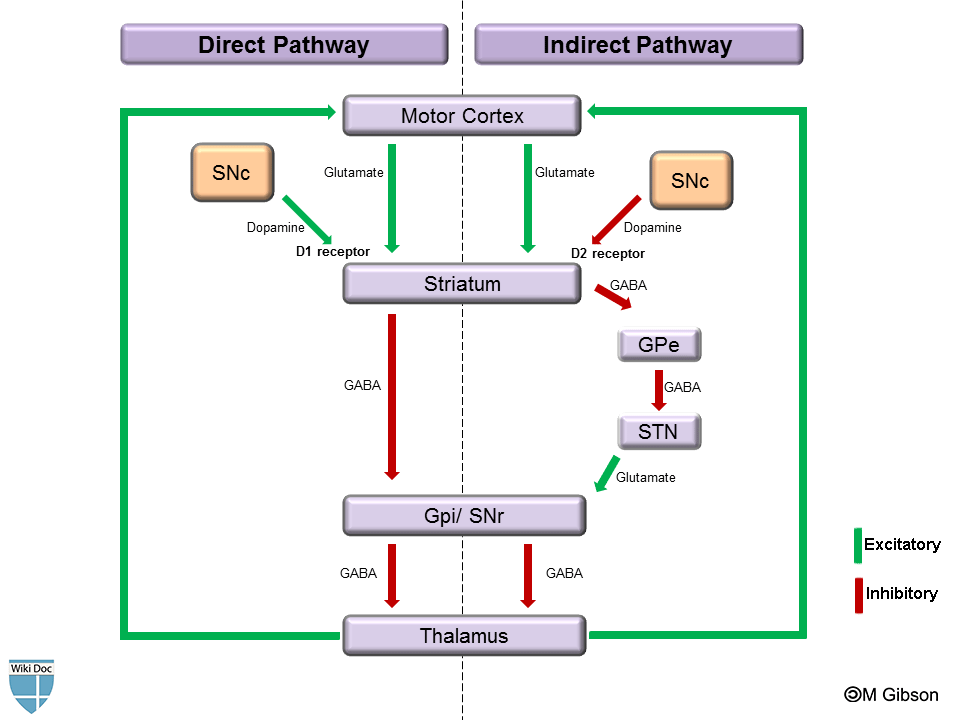WBR0590
| Author | [[PageAuthor::Rim Halaby, M.D. [1]]] |
|---|---|
| Exam Type | ExamType::USMLE Step 1 |
| Main Category | MainCategory::Anatomy |
| Sub Category | SubCategory::Neurology |
| Prompt | [[Prompt::Deep brain stimulation (DBS) is an invasive procedure used for the treatment of advanced Parkinson's disease. It consists of surgically implanting a device that sends high frequency electrical impulses into areas of the basal ganglia, particularly the subthalamic nucleus (STN) and globus pallidus internus (GPi). Several hypotheses explain the mechanism by which DBS improves parkinsonism symptoms; one of which suggests that DBS causes hyperpolarization in the STN leading to a decrease in its excitability. Decrease of the excitability of the STN leads most probably to which of the following changes in neurotransmitter release?]] |
| Answer A | AnswerA::Decrease of glutamate release from STN and decrease in GABA release from GPi |
| Answer A Explanation | AnswerAExp::This answer is correct because the inhibition of the STN leads to decrease glutamate release causing less stimulation of the GPI and hence less release of GABA. |
| Answer B | AnswerB::Decrease of glutamate release from STN and increase in GABA release from GPi |
| Answer B Explanation | AnswerBExp::This answer is incorrect because the inhibition of the STN leads to decrease glutamate release causing less stimulation of the GPI and hence less release of GABA. |
| Answer C | AnswerC::Increase of glutamate release from STN and increase in GABA release from GPi |
| Answer C Explanation | AnswerCExp::This answer is incorrect because the inhibition of the STN leads to decrease glutamate release causing less stimulation of the GPI and hence less release of GABA. |
| Answer D | AnswerD::Increase of glutamate release from STN and decrease in GABA release from GPi |
| Answer D Explanation | AnswerDExp::This answer is incorrect because the inhibition of the STN leads to decrease glutamate release causing less stimulation of the GPI and hence less release of GABA. |
| Answer E | AnswerE::Decrease of glutamate release from STN and no change in GABA release from GPi |
| Answer E Explanation | AnswerEExp::This answer is incorrect because the inhibition of the STN leads to decrease glutamate release causing less stimulation of the GPI and hence less release of GABA. |
| Right Answer | RightAnswer::A |
| Explanation | [[Explanation::The indirect pathway of the basal ganglia begins when the motor cortex stimulates the striatum which releases GABA. GABAreleased by the striatum has an inhibitory effect on the globus pallidus externus (GPe), and hence leads to less GABA release from GPe which in turn regulates the STN. Normally the STN releases glutamate stimulating GPi to release GABA. GABA released by the GPi decrease the firing of the thalamus towards the motor cortex and consequently decrease motion. Inhibition of the STN leads to decrease glutamate release causing less stimulation of the GPI and hence less release of GABA. Decrease in the inhibitory effect of GABA on the thalamus causes increase in motion.
Shown below is an image summarizing the direct and indirect pathway of the basal ganglia.  Educational Objective:
In the indirect pathway of the basal ganglia, STN stimulates GPi through glutamate. GPi releases GABA and decrease excitatory signal release from the thalamus. The outcome is fine tuning of voluntary movement by decreasing motion. |
| Approved | Approved::No |
| Keyword | WBRKeyword::Basal ganglia, WBRKeyword::STN, WBRKeyword::neurotransmitter |
| Linked Question | Linked:: |
| Order in Linked Questions | LinkedOrder:: |